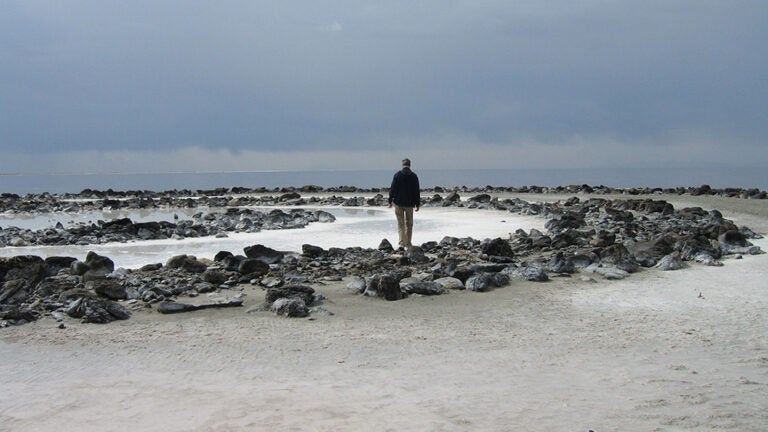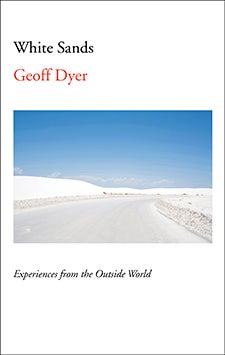
USC Dornsife Writer in Residence Geoff Dyer publishes White Sands
Liberally infused with generous helpings of the author’s deadpan wit and philosophical wisdom, Geoff Dyer’s new book White Sands: Experiences from the Outside World is both enlightening and hilarious.
In the genre-defying work out from Pantheon this month, Dyer’s secular pilgrimages are permeated with the disappointment of not encountering what he ostensibly set out to find. Yet, his blighted hopes are constantly redeemed by the joy of finding other things on the journey — things unexpected and more intriguing than what was originally sought.
Among the tales in White Sands are a trip to Norway, during which the USC Dornsife writer in residence and his wife, spectacularly fail to see the longed-for spectacle of the Northern Lights, a deeply unsatisfying voyage to Tahiti to walk in artist Paul Gauguin’s footsteps, and a curtailed sightseeing tour of Los Angeles’ Watt Towers.

The cover of Geoff Dyer’s latest collection of essays, published in May by Pantheon Books.
If the settings could not be more disparate, certain common themes emerge, one being that Dyer’s stories are never what they seem. The title story “White Sands,” for instance, ostensibly an essay on the author’s visit with his wife to the eponymously named New Mexico state park, metamorphoses into a darkly humorous nail-biter. The couple pick up a hitchhiker shortly before seeing a roadside sign warning motorists against doing that very thing, as the area is home to several criminal detention centers.
“After we saw the sign,” Dyer writes, “the vibe in the car — which had been a good vibe — changed completely and became a very bad vibe.”
Dyer’s desire to see Gauguin’s 1897 masterpiece Where Do We Come From? What Are We? Where Are We Going? launches this series of essays. The painting was — of course — disappointingly not on display when Dyer went to see it. But its title clues us in to some of the elemental questions the author tackles in this volume.
Here, Dyer, winner of the 2015 Windham Campbell Prize for Nonfiction, discusses his new book, explores some of his greatest influences and gives advice to undergraduates — or indeed anyone — with ambitions to be a writer.
The importance of place
If Dyer rejects any suggestion that his work could be pigeon-holed as travel-writing, he embraces the importance of place in both his fiction and nonfiction, stressing that nothing has been more important to him as a writer.
The importance of tone
Dyer’s distinctive voice allows his writing to flow from the philosophical to the fanciful, the serious to the humorous.
“After place there is nothing more important for me than tone,” he said. “The tone that I have arrived at is a product of me assimilating lots of influences. It’s a combination of serious and very deadpan. The key thing for me is that you don’t see the jokes coming, that I’m not condemned to just being in the funny tone. Weirdly I find that, rather than limiting me to just being funny, it frees me to go into other more analytical kind of stuff.”
Nonfiction as work of art
Dyer is the author of four novels and nine works of nonfiction. The latter occupy a particular place in the world of English letters, a place where the borderline between fiction and nonfiction is deliberately — and intriguingly — blurred.
“It’s been one of the bees in my bonnet, this idea of the nonfiction work of art,” he said. “There’s this notion that typically you go to fiction for style and inventiveness and you go to nonfiction for the information, the content, and if the nonfiction book is well written that’s a sort of bonus. This is why I am always trying to make a case for the nonfiction book that is defined by the experience you are having as opposed to the book that you go to for the content.”
The importance of photography
Nobody has had a greater influence on Dyer than the British art critic John Berger, author of the iconic essay “Ways of Seeing.” It comes as no surprise then that the visual — and in particular photography — is a major source of Dyer’s inspiration.
On his next project
Dyer describes his next project as “an unusual take on Gary Winogrand,” the iconic mid-century American street photographer whose photograph of White Sands first inspired the author to visit the National Monument in New Mexico.
“I’m crazy about Winogrand. As far as possible I’m using the pictures as jumping off points for some other stuff. Ideally this book about the street photographer will be a book about some sort of street philosophy.”
On becoming a writer
Dyer firmly believes you become a writer by becoming a reader.
“Reading shouldn’t be onerous. Much more important than writing if you’re an undergraduate is developing the habit of becoming a very eager reader. Partly so that you don’t waste time reinventing the wheel.”
Dyer stresses the importance of reading older, rather than contemporary, works, “not because in some sort of antiquarian way the world has gone to pot since the great days of Dickens, but so you’ve got that foundation. Then the more recent stuff can be built on that.”
The essay as journey
For a writer, Dyer notes, the inspiration inherent in travel also exists in metaphorical journeys.
The importance of grammar, rigor and style
Dyer often speaks to students about the false notion that being creative and being rigorous are in opposition.
“I’m always stressing that you’ve got to be a reader and you’ve also got to be properly in command of your grammar,” he said. “You’ve got to know what a sentence is. And that really boring stuff — you’ve got to get it right.”
He emphasized the importance of having a foundation of correct usage.
“Martin Amis wrote something like, ‘Style isn’t like a polish that you put on at the end of a car wash to give the car a nice gleaming finish.’ It’s something that is integral to perception and one’s particular style of writing.”